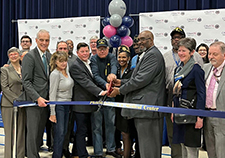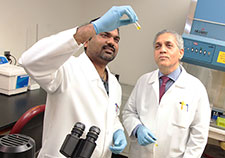Office of Research & Development |
 |
Office of Research & Development |
 |


Research at the Washington DC VA Medical Center is looking at better ways to ward off the muscle loss that comes with aging. (Photo for illustrative purposes only. ©iStock/adamkaz)
April 18, 2018
By Mitch Mirkin
VA Research Communications
You’re at the gym, doing a bench press. You push up, raising the barbell—that’s the “concentric” phrase. Now you ease the weight down toward your chest—that’s what exercise physiologists call the “eccentric” phase.
(That’s pronounced “ee-centric.” Not “eck-centric,” like a millionaire who wears old, rumpled clothes and leaves all his worldly possessions to his cats.)

Dr. Michael Harris-Love directs the Muscle Morphology, Mechanics and Performance Laboratory at the Washington DC VA Medical Center. (Photo by Mitch Mirkin)
VA’s Dr. Michael Harris-Love is a believer in the benefits of this particular form of physical exertion—eccentric exercise, aka negative work training. Google the term and you’ll find lots of sites devoted to elite athletes with chiseled physiques and bulging muscles.
But Harris-Love, with the Washington DC VA Medical Center and George Washington University, is developing and testing programs that make specific use of eccentric training to help Veterans and others with a range of ailments and health challenges—including the frail elderly.
One health problem in his crosshairs is sarcopenia: the gradual drop in muscle mass, strength, and function that comes with aging. Strength training and good nutrition can help prevent sarcopenia. Harris-Love asserts that eccentric training may be just what the doctor ordered when it comes to stopping or slowing the condition.
"We want to look at muscle health in a way that is less costly, more efficient, and more comprehensive."
The investigator, who was a weightlifter himself before going on to become an exercise physiologist, physical therapist, and health science researcher, explains that eccentric training can offer more bang for the buck: It can work the muscles with less stress on the heart, compared with conventional strength training.
“What’s interesting about lengthening contractions [during the eccentric phase of an exercise, the muscles lengthen] is that they place lower metabolic demands on the body. They use less oxygen for the same amount of energy. You tend to be 20 to 35 percent stronger eccentrically than concentrically, and there’s less cardiovascular demand. So for some infirm populations, light eccentrics might be useful because it’s less demanding on the heart.”
His team is now looking at data from a study they did with people who had knee arthritis. “It’s a paradox,” he says. “Eccentrics has this reputation of huge muscle forces, and there are some risks for athletes for who may train this way. But here was this [older] population that was able to do it lightly and get some benefit out of it, despite having some physical limitations.”
Harris, who, among other funding sources, has a Career Development Award from VA Rehabilitation Research and Development, directs the Muscle Morphology, Mechanics and Performance Laboratory (3MAP Lab) at the DC VA Medical Center. One study now underway there is focused on detecting and treating sarcopenia and a related condition, myosteatosis—the build-up of fat in the muscles, which makes them less functional—in older African Americans.

VA opens new research center to seek novel arthritis treatments

Molecular delivery system takes arthritis drugs directly to joints

Knee popping? You may be at risk for arthritis

Chemical shows promise in subduing joint inflammation in rheumatoid arthritis
The study participants visit 3MAP or a lab at Howard University for an initial assessment. Veteran participants do strength exercises two days a week for 12 weeks at the DC VA Medical Center: shoulder presses, arm curls, seated rows, leg presses. One group does an eccentric version, while the others do the standard concentric version.
The research lab has specialized—and pricey—equipment that makes eccentric training more feasible and more effective, namely through the use of flywheels to modulate resistance in different phases of an exercise.
Harris-Love and his team run tests on the volunteers to check their body composition and chemistry as they progress through the study. He wants to know whether the eccentric-exercise group fares any better in outcomes like total lean body mass, fat within the muscles, muscle strength, and glucose and insulin levels.
The researcher says myosteatosis—fat within muscle tissue—worsens the effects of sarcopenia, and may play a role in driving diabetes, which is particularly common among older African Americans.
Other 3MAP research is exploring ultrasound as a way to detect sarcopenia in the first place.
The impetus for the project, says Harris-Love, was that most geriatricians or primary care providers don’t screen for sarcopenia at all. “You can’t manage what you don’t measure,” says the investigator. He points out that muscle accounts for some 30 to 40 percent of our body mass, on average. “We measure blood pressure, heart rate. Why not screen for problems with our muscles?”
He believes ultrasound can change that dynamic.
Currently, when doctors do decide they need to assess lean body mass—the total weight of the body, including muscles, organs, skin, bones, and water, but minus fat—they order a type of low-radiation X-ray called a DXA scan, which is also used to check bone density. If they want further insight into the composition of the muscle tissue, short of doing an invasive biopsy, they will order a CT scan, which is more expensive and involves more radiation than a DXA test.
Ultrasound usually doesn’t enter into the discussion. Most people are familiar with the imaging technology—which uses sound waves—as a way to check on a fetus, or the heart. While it may be used to look at problems such as muscle tumors or injuries, rarely is it used in current practice to examine muscle composition.
But Harris-Love sees at least three advantages to ultrasound that could potentially make it a routine tool for sarcopenia screening.
First, it’s a relatively low-cost option to examine muscle tissue. In VA, according to Harris-Love, ultrasound scans typically cost the heath care system around $25 to $50 per imaging session. DXA scans run around $100. CT scans can vary greatly in cost, depending on several factors, but can be at least $300. Part of the lower cost of the ultrasound is that the technology is more mobile and requires less physician involvement than the other two.
Second, ultrasound is thought to be safer for patients, in that it has no radiation, unlike a CT or DXA scan—although CT scans do offer the highest resolution of any of the three, for cases when that is critical.
Third, for experts who know what to look for, ultrasound can tell more about the health of muscles than can the DXA scan. The more commonly used DXA method estimates lean body mass, but not what’s going on inside the muscle—namely, whether fat cells have crept in.
“Muscle mass alone doesn’t always predict function when you become older,” says Harris-Love. “If you put an older person in a DXA scan, it would measure the amount of muscle, and sometimes the muscle mass is pretty good. But the person still gets weaker. So the question is why.”
One probable answer, he says, has to do with fat.
“There may be a lot of reasons, but one big factor is muscle quality. I can maintain the same volume of muscle, but something called intramuscular fat starts to infiltrate muscle.”
With ultrasound, he says, “I’m able to look inside the muscle as well, so I’m able to estimate how much fat is there.”
All in all, he says, “We want to look at muscle health in a way that is less costly, more efficient, and more comprehensive,” and he believes ultrasound delivers on all three counts.
He isn’t advocating for routine muscle ultrasounds for everyone, or all people over a certain age. But he does think it could be the go-to confirmatory test for those with low strength or function.
At the very least, Harris-Love hopes to get doctors and other providers thinking more about sarcopenia than they do now. That can bring a big payoff, he says, in preventing disability and improving function and quality of life for older Veterans and other patients, he says.
“Even if people don’t buy the methods we’re using, if we can at least change the conversation, we’ve accomplished something.”
VA Research Currents archives || Sign up for VA Research updates